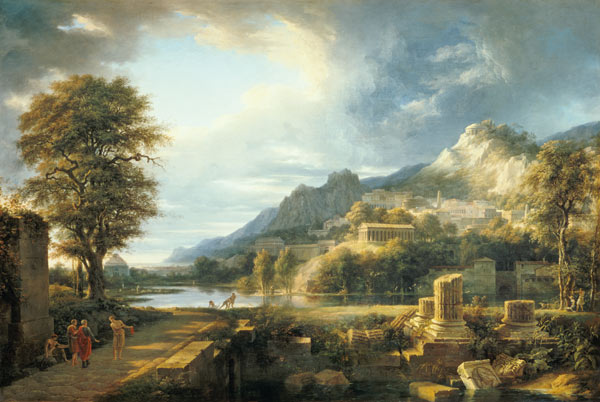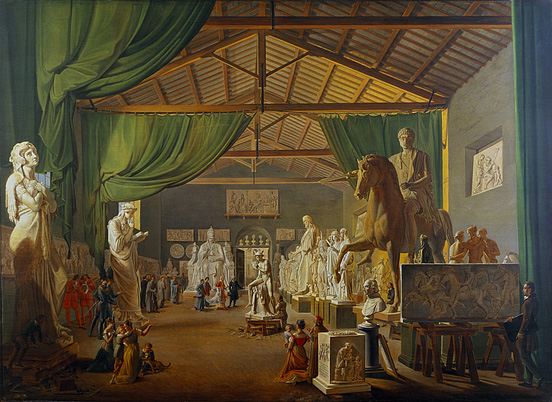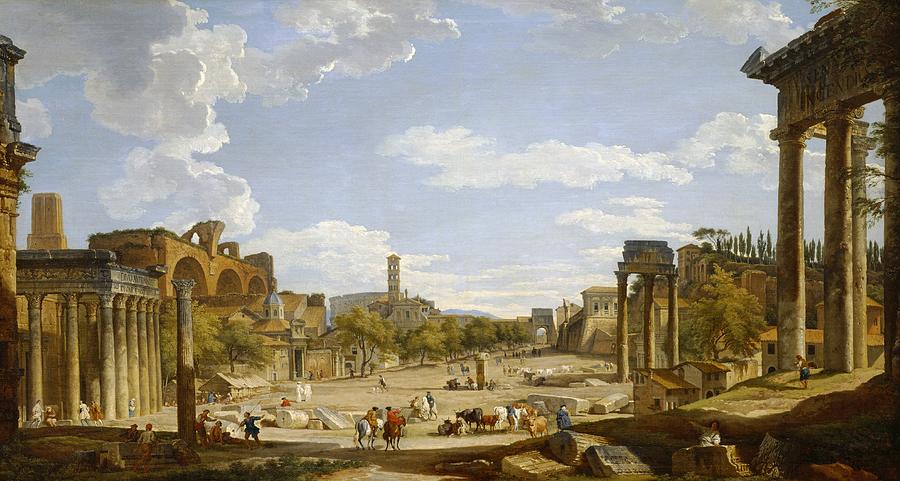Michelle Scott - Symbols of Death, Rebirth
and the Ideal in Neoclassical Art
The term neoclassical refers to the style of art most popular from
1750-1830. During these years, upheavals were to be found in all human
endeavors. In philosophy, Locke, Burke, Voltaire, Rousseau, Kant and
Schopenhauer were presenting their contradictory views of human nature
(Magee, 2001, p. 5). In politics, French
governments came and went with alarming frequency, Napoleonic conquests
signaled regime changes all across Europe, and the American colonies
split from England and created a new system of government. In the
arts, though, a single style was overwhelmingly dominant, the neoclassical
style (Hawley, 1964, p. 3). What was
it then, about the neoclassical style that so impressed its contemporaries
that it dominated its era? Specifically, what was it about one motif,
classical ruins, which caused it to be repeated in so many individual
works?
According to Carl Jung, archetypal imagery, found repeated and dominant
in a culture, are evidence of commonly held obsessions and ideas.
An example he used was of the Nazi party's use of symbols before and
during World War II to stir the popular consciousness (Jung,
1976, p. 65-67). For our purposes, there are three layers
to Jung's theory. Jung's theory of mind proposed that there were two
divisions of the unconscious mind, the personal unconscious and the
collective unconscious. The content of the collective unconscious
is archetypes, just as that of the personal unconscious is personal
memory. Archetypes are forms that human ideas, emotions, and drives
may take, and are expressed as symbols. Symbols are the specific images
that make it possible for us to understand the abstract. The most
commonly recognized symbols are anthropomorphic symbols, such as heroes,
tricksters, or divine figures that represent other human attributes.
However, Jung also recognized other types of archetypes and symbols:
There are archetypes whose content is less anthropomorphic, less
readily personalized, such as the archetype of wholeness or the
archetype of rebirth. These archetypes Jung called archetypes
of transformation, "typical situations, places, ways and
means, that symbolize the kind of transformation in question."
(Hopcke, 1999, p.15)
Jung further broadened his definition of the archetype to say that
"there are as many archetypes as there are situations in life
(CW9.99)." (Clarke, 1992, p. 117).
The repetition of the themes of classical ruins in neoclassical
art is an example of an archetype at play. The neoclassical era was
an unusually unstable one and the people of the era looked back to
classical times as an example of life at its best. The ruins therefore
become symbols of three primary ideas: what was lost, what was ideal
and what would always be. There are many paintings that could be used
to typify this idea, but we will look at three: Panini's The Roman
Forum from 1735, Pierre-Henri de Valenciennes' The Ancient
City of Agrigentum: Ideal Landscape from 1787, and Hans Ditlev
Christian Martens' Thorvalds' Studio in Rome (with Pope Leo XII
Visiting in 1826) from 1830.
 The Ancient City of Agrigentum
The Ancient City of Agrigentum, The Louvre |
 Thorvalds' Studio in Rome
Thorvalds' Studio in Rome, State Museum of Art, Copenhagen
|
Giovanni Paolo Panini's work is perhaps
the best known of the neoclassical landscapes. The Roman Forum
shows our three archetypal symbols fairly simply. The idea of loss,
or death, is conveyed in the ruined architecture itself. The columns
that once held up the city (like a skeleton) are broken and on the
ground, the aqueduct (which functioned similar to a circulatory system
for providing water to the city) also survives only as a fragment.
There are hovels among the ancient structures to contrast between
the classical architecture and the illiteracy that followed its era.

The Roman Forum, Detroit Institute of Arts
The Ideal is found in the choice of the Forum
for Panini's setting. The Forum in Roman life symbolized Rome's dominance
in the classical world, both in terms of raw political power and in
terms of cultural dominance. Miniature replicas of the Forum were
to be found all over the classical world, as Roman settlers spread
out to found new settlements. By the neoclassical era, the old Roman
ideas of republic and empire were rapidly gaining in popularity, so
the Forum could also represent the Ideal form of government for both
traditionalists and for republicans. Also significant in the painting
is how many figures are pointing to various structures, as if to highlight
their magnificence to the viewer.
Finally, the idea of rebirth is presented in the painting. Not
only are live people in modern dress a part of the painting, but also
animals and plants. The ruins have plants growing in and on them,
so that they have taken on a new kind of life. Everyday business is
being transacted in the Forum again. Not as noticeable are the contemporary
structures interspersed with the classical ruins; besides the hovels
there are also structures built with classical ideals of form in mind.
Pierre-Henri de Valenciennes The Ancient City of Agrigentum:
Ideal Landscape takes a middle ground between the neoclassical
landscapes that depict classical ruins and works that portray life
in the classical era. (Another of Valenciennes' works, Cicero Discovering
the Tomb of Archimedes, is here:
Symbols of loss and death can be found in the foreground of his work.
The scene takes place at sunset. As in Panini's work, broken columns
litter the ground, and there is even a broken infinity symbol that
has fallen halfway into a lake. Behind the columns are a small party
of hunters preparing to shoot a bird, and fishermen are hauling in
their catch for the day. The ideal can be found in two places in Valenciennes'
work. First, there is the well-lit classical city on the hill. Also,
in the bottom left corner of the painting are symbols of perfect hospitality:
a wealthy man has sent his servant to welcome strangers passing on
the road to his home for the night (Irwin, 1997,
p. 204). Symbols of rebirth can be found in the middle
ground as a woman is gathering food near a lake. Also interesting
is that while the vegetation among the ruins seems to be barely clinging
to life, the plants and trees in the hilltop city are healthy.
Then, there is Hans Ditlev Christian Martens' Thorvalds' Studio
in Rome (with Pope Leo XII Visiting in 1826). Strictly speaking,
the piece does not present actual ruins at all; they are implied by
the fact that several sculptures from different eras are housed protectively
in a modern building. The pieces being displayed so obviously out
of context, then, is a symbol of loss in that the original context
has been lost to the viewer. The sculptures also represent an ideal.
First, they are worth preserving in the first place. Also, representatives
of the most important social groups of the era are shown studying
them (the Pope, a small aristocratic family, soldiers, and scholars).
The painting also represents rebirth, or more strictly in this case,
continuity with the classical era. Along side monumental statues of
Roman generals and the three graces, stand Christian sculptures of
Biblical figures. In the foreground is also found a contemporary bust
of a philosopher or political leader.
In Jung's mind, recurring themes in art represented the common
obsessions of the era in which they were created, because the fact
that the theme resonated with a person was proof of its archetypal
foundation. Symbols of Death, Rebirth, and the Ideal were particularly
powerful for people living in an era of frequent revolution and political
idealism, and this power is reflected in the art of the era.
Works Cited
Hopcke, Robert H. (1999). A Guided Tour of the Collected Works
of C. G. Jung. Boston: Shambhala Publications.
Clarke, J. J. (1992). In Search of Jung: Historical and Philosophical
Enquiries. New York: Routledge.
Hawley, Henry. (1964). Neoclassicism: Style and Motif. Cleveland,
OH: Cleveland Museum of Art.
Jung, C. G. The Concept of the Collective Unconscious. In Joseph Campbell
(Ed.).
Magee, Bryan. (2001) The Story of Philosophy. New York: Dorling
Kindersley.
Irwin, David. (1997). Neoclassicism. London: Phaidon Press
Limited.
(1976). The Portable Jung. New York: Penguin.